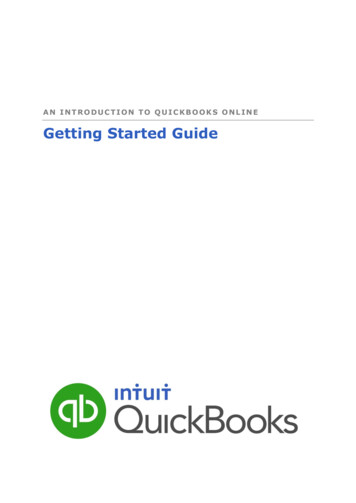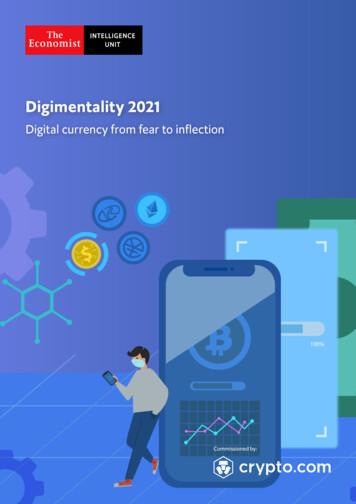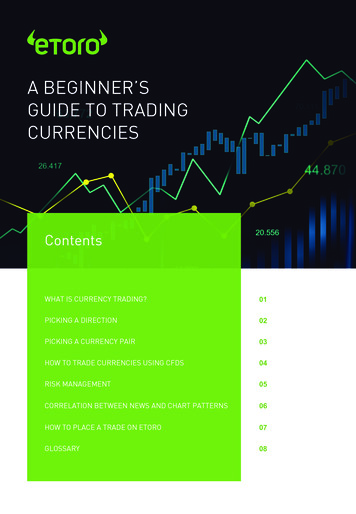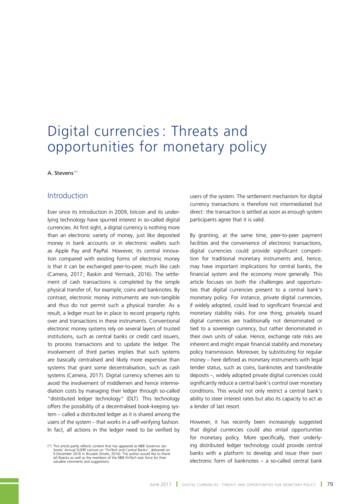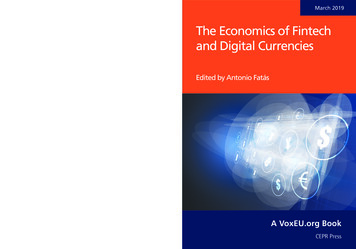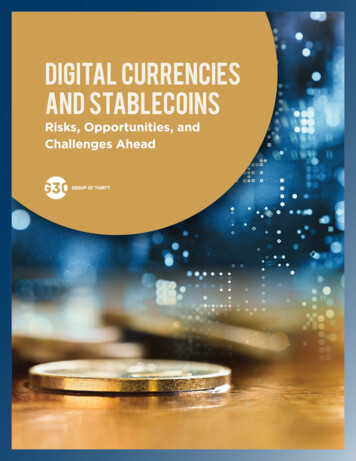
Transcription
DIGITAL CURRENCIESAND STABLECOINSRisks, Opportunities, andChallenges Ahead
DisclaimerThis report is the product of the Group of Thirty’s Steering Committeeand Working Group on Digital Currencies and reflects broad agreementamong its participants. This does not imply agreement with every specificobservation or nuance. Members participated in their personal capacity,and their participation does not imply the support or agreement of theirrespective public or private institutions. The report does not representthe views of the membership of the Group of Thirty as a whole.ISBN 1-56708-179-7Copies of this paper are available for US 25 from:The Group of Thirty1701 K Street, N.W., Suite 950Washington, D.C. 20006Tel.: (202) 331-2472E-mail: info@group30.org, www.group30.org
DIGITAL CURRENCIESAND STABLECOINSRisks, Opportunities, andChallenges AheadPublished byGroup of ThirtyWashington, D.C.July 2020
WORKING GROUP on Digital CurrenciesSTEERING COMMITTEERaghuram Rajan, Co-ChairProfessor of Finance, Chicago BoothSchool of BusinessFormer Governor, Reserve Bank of IndiaKenneth Rogoff, Co-ChairProfessor of Economics, Harvard UniversityFormer Chief Economist, InternationalMonetary FundArminio FragaFounding Partner, Gavea InvestimentosFormer Governor, Banco Central do BrasilJacob FrenkelFormer Governor, Bank of IsraelFormer Chairman, JPMorgan Chase InternationalAgustín CarstensGeneral Manager, Bank for International SettlementsFormer Governor, Banco de MéxicoWORKING GROUP MEMBERSJaime CaruanaFormer General Manager, Bank forInternational SettlementsFormer Governor, Banco de EspañaMasaaki ShirakawaDistinguished Guest Professor,Aoyama-Gakuin UniversityFormer Governor, Bank of JapanTharman ShanmugaratnamSenior Minister, SingaporeChairman, Monetary Authority of SingaporeZhou XiaochuanPresident, China Society for Finance and BankingFormer Governor, People’s Bank of ChinaPROJECT ADVISORSDarrell DuffieAdams Distinguished Professor of Managementand Professor of Finance, Stanford GraduateSchool of BusinessHyun Song ShinEconomic Adviser and Head of Research,Bank for International Settlements
EXPERTSStuart MackintoshExecutive Director, Group of ThirtyMu ChangchunDirector-General of the Digital Currency Institute,People’s Bank of China
Table of ContentsForeword. viiAcknowledgments. viiiAbbreviations. ixIntroduction. 11. Background. 5Deposit-Based Systems. 5Token-Based Systems. 82. Policies regarding compliant digital currenciesand payment service providers . 11Private Stablecoins. . 11Direct central bank digital currency. 14Indirect CBDC or Hybrid CBDC . 16Wholesale CBDCs. . 19Coordinating the introduction of global official-sector stablecoins. 19Upgrade to faster and more open bank account-based payments. 203. An approach to evaluating the policy options . 21Conclusions. 23References. 25Group of Thirty Members 2020. 29Group of Thirty Publications Since 2010. 33
BOXESBox 1. The India Stack: Public Infrastructure, Largely Private Provision. 6Box 2. Tether. 12Box 3. Libra. 13Box 4. China’s Nascent Central Bank Digital Currency. 17
FOREWORDThe Group of Thirty (G30) aims to deepenunderstanding of international economic andfinancial issues, and to explore the internationalrepercussions of decisions taken in the public andprivate sectors. This report, Digital Currencies andStablecoins: Risks, Opportunities, and ChallengesAhead, continues the G30’s over 40-year tradition ofevidence-based, actionable study.Decisions taken by policymakers on digital currencies, now and over the next few years, could potentiallyshape the global financial system for decades to come.The report urges that central banks and regulatorstake an active role in setting standards and in shapingor providing market infrastructure, and not leavedesign purely to market forces. Moreover, there is acompelling case for international cooperation on theseissues, which extends to data-sharing protocols andcybersecurity, among other issues.This report hopes to guide central banks and regulators as they consider the policy choices presentedJacob A. FrenkelChairman, Board of TrusteesGroup of Thirtyby new payment technologies and the entrance oftech players into the global payments arena. How canwe improve the efficiency of payment systems whilesafeguarding financial stability, monetary policytransmission channels, financial inclusion, investorprotection, and countering illicit activities? Underwhat parameters should central banks deploy theirown digital currencies?We hope that the report’s recommendations, whentaken together and considered within the context ofnational economies and financial systems, will supportthe necessary debate on how the financial system canbest provide efficiency and stability going forward.On behalf of the G30, we extend our thanks toRaghuram Rajan and Kenneth Rogoff for theirextremely able co-chairing of the Working Group onDigital Currencies, and to the two Project Advisors,Darrell Duffie and Hyun Song Shin, for the considerable expertise and thought they brought to the report’sanalysis and recommendations.Tharman ShanmugaratnamChairmanGroup of ThirtyGROUP OF THIRT Y vii
ACKNOWLEDGMENTSOn behalf of the Group of Thirty (G30), we wouldlike to express our appreciation to those whosetime, talent, and energy have driven this projectto a successful completion.We would like to thank the members of theSteering Committee and Working Group on DigitalCurrencies, who guided our collective work at everystage and added their unique insight and inputs. Theintellect and experience they brought to the table havebeen paramount in informing the important subject ofdigital currencies and stablecoins and the challengesthey present to policy makers, central banks, andfinancial regulators.Raghuram RajanCo-ChairWorking Group on Digital CurrenciesThe G30 extends its deep appreciation to the ProjectAdvisors, Darrell Duffie and Hyun Song Shin, for theircommitment to the project and tireless work and contributions to the analysis and formulation of the report.The coordination of this project and many aspectsof project management, Working Group logistics, andreport production were centered at the G30 offices inWashington, D.C. This project could not have beencompleted without the efforts of our editor, DianeStamm, and the work of Executive Director StuartMackintosh and his team, including Desiree Maruca,Emma Prall, and Peter Bruno of the G30. We aregrateful to them all.Kenneth RogoffCo-ChairWorking Group on Digital Currenciesviii Digital Currencies and Stablecoins: Risks, Opportunities, and Challenges Ahead
AbbreviationsAML/CFTanti-money laundering/combating the financing of terrorismAPIsApplication Process InterfacesCBDCcentral bank digital currencyDC/EPDigital Currency Electronic Payment (China)DNAdata-network-activitiesFINMAFinancial Market Supervisory Authority (Switzerland)fintechfinancial technologyHKMAHong Kong Monetary AuthorityHQLAhigh-quality liquid assetsKYCKnow Your CustomerPSPsPayment System ProvidersRTGSReal Time Gross SettlementUPIUniversal Payment InterfaceGROUP OF THIRT Y ix
IntroductionRecent developments have heightened the attentionof financial authorities to opportunities and challenges posed by new forms of digital currency,including privately-issued “stablecoins” as well ascentral bank digital currencies. This paper aims tocontribute to that discussion. As central banks andfinance ministries consider how to respond to therapidly evolving digital payments landscape, theycould revisit more basic choices regarding monetaryarrangements. These include the foundational roleof the central bank as well as more detailed policychoices concerning how to: ensure the continuedoperation of monetary policy transmission channels;improve the efficiency of payment systems—especiallyacross borders; safeguard financial stability; expandfinancial inclusion; enhance investor protection;and counter illicit activities. How can central banksmake the best use of the possibilities afforded bynew payment technologies, especially digital currencies? Should central banks deflect or support “tech”entrants to the payments arena? If they support techentrants, should these new players be accommodatedinto the current two-tier monetary architecture, withthe central bank at the core of the system, and whoseinner tier has until now been essentially restricted tobanks? Although the focus of this note is central bankpolicy, the challenge posed by disruption from digitalcurrencies affects all branches of government, not tomention international financial organizations such asthe International Monetary Fund and the World Bank.Of course, private-sector financial firms and Fintechinnovators also have a huge stake in how financialregulation evolves to shape the landscape.Central banks have allowed a variety of innovationsin payment mechanisms, with a view to enhancingcompetition among them. Barriers to entry can belowered when innovative private solutions can beplugged into public infrastructure, including centralbank settlement accounts. Several central banks haveresponded to the emergence of new non-bank paymentservice providers (PSPs) by expanding access to centralbank settlement accounts with a view to enhancingcompetition. Each of these innovations is based on adivision of labor by which the official sector providesthe core infrastructure while private-sector entrantsdraw on their innovative capacity.During the early development of digital currencies, authorities generally took a hands-off attitude,not wanting to interfere with technological innovation. Whereas technological development remains animportant objective, we argue that the time has comefor the official sector to play a more decisive role inshaping developments.In the near term, a policy of requiring new paymenttechnology providers to meet at least existing functional outcome standards seems obvious. As newpayment methods appear, relevant regulatory frameworks need to be mapped and checked for coverageof all critical standards, including investor protectionrules, principles for financial market infrastructure,and various standards for the legality of transactions(for example, with respect to anti-money launderingand countering the financing of terrorism), amongother relevant regulations. Some new payment technologies cut across traditional lines of jurisdictionalresponsibility, calling for coordination among regulators, domestically and internationally.GROUP OF THIRT Y 1
Over the medium term, a number of other policyquestions will become salient. These include:1. Should central banks issue their own digital currencies for use in the broader economy, or is the betterstrategy to update and upgrade existing structures?2. What is the appropriate degree of competitionbetween domestic digital currencies, especiallybetween private versions and the central bankversion?3. How should a central bank or legislature react ifa non-native digital currency is gaining domesticpopularity in payments relative to the native fiatcurrency?4. What is the appropriate public policy stance on thedisruption of conventional banking by paymentsystem innovation?5. What policy approaches are needed to promote thesecurity of the payment system as digital innovations continue to evolve?6. What should be the protocols for acquiring, owning,and sharing data collected in domestic paymentstransactions? How should these apply to the international sharing of transactions data?Before addressing these questions, it is useful toclarify certain terminology. Payments can be smallvalue retail payments or large-value wholesalepayments. Payments usually have a front end (howthe payment is initiated) and a back end (how it iscleared and settled). For example, I initiate a paymentto my landlord by sending her a check, and the processby which the money shows up in her account involvesclearing and settling—with money effectively movingfrom my bank’s account with the central bank to herbank’s account with the central bank as final settlement. Underlying all transactions is the country’s fiatcurrency, which simultaneously serves as a unit ofaccount, a medium of exchange, and a store of value.This two-tier system—with the public havingdigital accounts with commercial banks from whichthey can make payments and withdraw physicalcash, and commercial banks having accounts withthe central bank—is the current system in much ofthe world. As discussed above, in recent years, centralbanks have expanded the set of financial institutionsthat have central bank accounts, more payments areinitiated digitally rather than through checks, andthere is a constant effort to clear and settle transactions more quickly, but the fundamental architecturehas remained the same.A private cryptocurrency such as Bitcoin is a digitaltoken that can be transferred from peer to peer viacrypto graphic schemes that do not require identification. Cryptocurrencies offer varying degrees ofanonymity depending on the nature of the cryptographicscheme. They employ a variety of mechanisms to cleartransactions; “permissioned” systems rely on a centralauthority, which is the final arbiter of the clearing oftransactions (and therefore has access to the necessary records), while “permissionless” systems, suchas Bitcoin and Etherium, use cryptographic methodsto clear peer-to-peer transactions with no centralizedclearing authority.1 Finally, some cryptocurrenciesfluctuate significantly in value while others do not, orare structured to avoid revaluation.Central bank issued digital currencies (CBDCs)can also take different forms. 2 With indirect CBDC(which resembles the current two-tier system), the customer holds a claim on the intermediary, while thecentral bank focuses on wholesale accounts, including intermediary accounts at the central bank. So,for instance, the intermediary issues digital tokens tothe customer (which are claims on the intermediary),and handles Know Your Customer (KYC) issues anddisputes. Information on transactions resides withintermediaries. The customer claims on the intermediary are fully backed by intermediary claims on thecentral bank.1Throughout we use “permissioned” to refer to technologies where a central authority is involved in clearing transactions and “permissionless”to refer to ones where record-keeping can be decentralized. We recognize that “permissioned” is sometimes used differently in the cryptoliterature, but our distinction is the important one for the issues studied here. Although Bitcoin is permissionsless in theory, we note that, inpractice, most Bitcoin transactions are actually made on organized exchanges.2The following paragraph draws on Auer and Böhme (2020).2 Digital Currencies and Stablecoins: Risks, Opportunities, and Challenges Ahead
Direct CBDC can take two forms. In the first,everyone holds accounts at the central bank and anypayment transaction is simply a transfer from oneaccount to another. In the second, the central bankissues a digital token, and manages a permissionedsystem to clear transactions. While the central bankcan enlist intermediaries to do the initial KYC, allclaims are on the central bank, and all information ontransactions resides with it. Because it has the data,the responsibility of maintaining the customer relationship, including KYC, may inevitably devolve onthe central bank.In the hybrid CBDC, the claim is once again on thecentral bank, but the private intermediary plays a muchbigger role in transaction messaging. One examplewould be the issuance of a central bank digital tokenin lieu of cash (see the box 4 on the Chinese CBDC),with depositors able to withdraw digital tokens or cashfrom their account at the intermediary. Another wouldbe the intermediary offering its depositors individualaccounts at the central bank, with transactions initiated via the intermediary.Both direct CBDC and hybrid CBDC raise concernsabout possible disintermediation of private entities,especially in times of stress. Today, someone wantinga claim on the central bank must withdraw and storephysical cash, which entails transaction costs. Whenthe conversion to a CBDC from a deposit account atthe intermediary is just one click away, the transactioncosts are effectively zero.Having painted the landscape, albeit with a relatively broad brush, let us return to the originalquestions with which we started. We emphasize fourpoints. First, a key decision for central banks is howmuch to encourage new digital-token technologies, oreven to create a general-purpose central bank digitalcurrency, as opposed to strengthening existing frameworks. For example, much can be done to expandthe speed and availability of real-time clearing mechanisms, so that even retail transactions are clearedinstantaneously, 24/7.Second, even if there is a desire to encourage newtechnologies, there is still a variety of choices that canbe made on the specific architecture. For instance,“permissioned” systems allow authorities more3control and more data, but raise issues of privacy anddata use. Permissionless systems bring advantagesassociated with anonymity, but also bring risks.Third, governments must be able to collect taxes,enforce regulations, and limit illicit transactions. Theycannot idly allow a large fraction of their economy’spayments to be made through vehicles that are excessively costly to audit, either because of technology orbecause the key data are kept by a foreign governmentor a private entity outside their regulatory reach. Atthe same time, the more the central bank is involvedin payments, the more issues arise regarding whethercentral-bank-collected data are appropriately used ordisseminated, and whether the private sector has adequate incentives for innovation.Fourth, and perhaps most fundamentally for centralbanks, before any payments system is allowed tohandle a significant fraction of transactions, it must beproven exceedingly robust to breakdown, to theft, andto malicious destruction, including by state-sponsoredagents. In the world of modern cryptography, with constantly improving methods for breaking encryption,demonstrating such robustness is no small challenge.It may take many years, potentially even decades, tosatisfactorily harden a new payments system. (Eventhen, a payments system could be vulnerable to newtechnologies, such as quantum computing.)Even while we recognize both the merits of thecurrent system and the risks associated with change, weshould acknowledge the potential for significant contributions to growth and inclusion with sound digitallyenhanced payment systems. For instance, the data onpayments can be used to offer financial products likecredit in ways that significantly expand financial accessand competition, and innovative new instruments thatreprice or incorporate contractual contingencies canaugment “plain-vanilla” payments, thus bringingdown transaction costs and a variety of risks.3 Newdigital token technologies also allow for the possibilityof a vastly more efficient cross-border payment systemthat helps bring down the high transaction costs andeconomic rents currently embedded in it.With this introduction, we turn to a deeper exploration of the key issues.See, for example, Boissay et al. (2020).GROUP OF THIRT Y 3
4 Digital Currencies and Stablecoins: Risks, Opportunities, and Challenges Ahead
1. BackgroundWhy do token-based payment systems pose sucha new and potentially radical challenge toexisting financial structures? Although therehave been successive waves of innovations in paymenttechnologies over the last century, nothing until nowhas really posed the same degree of challenge to thelong-standing two-tier system, with central banks atthe hub and private banks (and related financial intermediaries) as the spokes. Credit cards, debit cards,electronic transfers, smart technologies, and essentially all innovative payment schemes are ultimatelycleared through this two-tiered payment system.Indeed, ever since bank-account-based moneybegan significantly displacing token-based money in17th-century Europe, there has been little conceptual change in payment mechanisms. A payment ismade when a bank debits the account of the payerand credits the account of the receiver. Although theelectronification of deposit-based payments increasedthe speed and convenience of payments, the basicarchitecture has remained relatively constant.Shortcomings in the performance of account-basedpayment systems—for example, high intermediationcosts (particularly for international transactions) andconstraints on real-time clearing of transactions—have left openings for tech sector entrants offeringdigital tokens, elevating the question of whethercentral banks should deploy their own general-purpose digital currencies and, if so, in what form.4DEPOSIT-BASED SYSTEMSBefore considering the far-reaching changes to thepayment systems that are made possible by technological advances, improvements to the current systemshould be explored in order to better understandtheir limits. Deposit-based payment systems are conventionally two-tiered: within the monetary systemassociated with a currency, the central bank is thebanker for commercial banks, which in turn providepayment-system access to others. Typically, domestic payments are settled with finality on the centralbank’s balance sheet through accounts provided tocommercial banks and other payment service providers (PSPs). In the cross-border context, payments aretypically processed through correspondent banks,but with significant costs in terms of delays and fees.The costs are larger when cross-border payments alsoinvolve currency conversion.Domestic payment systems have made importantstrides in terms of speed, convenience, and cost forthe user. However, progress has not been uniformacross jurisdictions, in some cases still leaving significant rents for payment service providers (mainlybanks), even in the United States. Based on paymentrevenue data reported in a recent McKinsey study,the ratio of payment revenues to GDP in the UnitedStates was 2.37 percent, while it was only 1.25 percentin Europe, the Middle East, and Africa.4 Similarly,although card spending in China is nearly 1.5 timesthat of the United States, it generates a revenue marginMcKinsey Global Payments Report 2019.GROUP OF THIRT Y 5
of roughly 1 percent compared to 3.5 percent in theUnited States.Ideally, a retail payment system would combineease of use, easy access, and a level playing field onwhich all system operators can compete. Some of thebiggest advances in retail payments have occurred indeveloping economies that are less hampered by legacysystems and the entrenched vested interests of incumbent players. The Indian Unified Payments Interface(UPI) is a good example of such an innovation and willbe discussed below.Attributes that ensure ease of use, access, and competition should include the following features. First,anyone who holds an account in a bank or non-bankfinancial institution can send and receive money fromanyone else within the system, at low latency and cost.This feature, “interoperability,” is most conducive toachieving equal conditions and low costs for users.Second, payments should settle in real time and withfinality. Third, transaction costs should be low. Thistypically requires the system to operate as a publicinfrastructure, on a cost recovery basis.More broadly, innovative private solutions thatcan be plugged into the existing public infrastructurecan be an important step toward lowering barriers toentry within the existing two-tier payment system,with central banks at the center, and banks and otherpayment service providers providing customer-facing services. Several central banks have respondedto the emergence of new non-bank payment serviceBOX 1. THE INDIA STACK: PUBLIC INFRASTRUCTURE,LARGELY PRIVATE PROVISIONIn 2008, only one in 25 people in India had formalto the Stack, thus creating the broadest networkidentification, and around one in four Indian adultseffects for all, even while encouraging innovation.had a bank account.* By some estimates, it wouldThe Stack also has structures for individuals tohave taken 47 years for 80 percent of adults toshare the data that is gathered on them.have a bank account in the normal course. Yet,The first platform on the Stack was Aadhaar,between 2011 and 2017, over 1.2 billion IndiansIndia’s unique digital identity system. E-KYC, theobtained a unique biometrics-based digital IDdigitalization of Know Your Customer (KYC), was(called Aadhaar), which was used to authenticatelaunched soon after, allowing for easier openingidentities some 900 million times a month. Overof bank accounts. Since then, other platforms470 million Indian adults opened a bank accountlike digital signature (for authentication), a digitalin a financial institution, and the share of thedocument repository, and the Universal Paymentpopulation with access to banking exceeded 80Interface (UPI) have been launched. In addition,percent. Digital retail payments using the Unifiedaccount aggregators now facilitate the transfer ofPayments Interface (UPI) exceeded a billionfinancial data among various regulated financialtransactions a month by November 2019. All ofinstitutions such as banks, insurance companies,this was made possible on public infrastructureand pension funds based on the individual’scalled the India Stack.consent. Thus, not only are the individual’s dataThe India Stack is a set of standards, infrastruc-aggregated, but neither the state nor any privateture components, and independent applicationentity that collects the data has a monopoly.programming interfaces (APIs) or platforms,Such account aggregators can emerge in othereach focused on a specific task, yet capable ofareas, like medical data.being laced together (or stacked) so that they canUPI is an instant real-time retail paymentexecute a general task. The intent is to allow allsystem, using an open API architecture devel-firms—irrespective of size—to have equal accessoped by the National Payments Corporation of6 Digital Currencies and Stablecoins: Risks, Opportunities, and Challenges Ahead
providers by expanding access to central bank settlement accounts, with a view to enhancing competition.For example, in 2017, the Bank of England adjustedits settlement accounts policies to allow access bynon-bank payment service providers. In May 2018,the Hong Kong Monetary Authority (HKMA) published guidelines for a “virtual banking” license. TheHKMA subsequently granted virtual banking licensesto a number of new financial technology (Fintech)entrants to the banking system. As licensed banks,these entities will be required to join the real-timegross settlement system (RTGS) and open a settlement account with the HKMA. Another exampleis Switzerland, where Fintech firms licensed underthe Swiss Financial Market Supervisory Authority(FINMA) are allowed access to an account at theSwiss National Bank.In all of these examples, there is a division of laborby which the official sector provides the core infrastructure while private sector entrants can draw ontheir innovative capacity to serve customers better.To reap the benefits of this division of labor, the coreinfrastructure provided by the central bank shouldbuild in a robust “back end” that promotes interoperability and a level competitive playing field amongpayment service providers. The Indian UPI system(see box 1) is an example of how such an infrastructure might be provided by the central bank. Thereis also scope for enhancing standards that promotesuch interoperability, such as the ISO 20022 SWIFTIndia, (NPCI)—a nonprofit owned by the ReserveIndia licensed payment banks, includingBank of Indi
finance ministries consider how to respond to the rapidly evolving digital payments landscape, they could revisit more basic choices regarding monetary arrangements. These include the foundational role of the central bank as well as more detail
